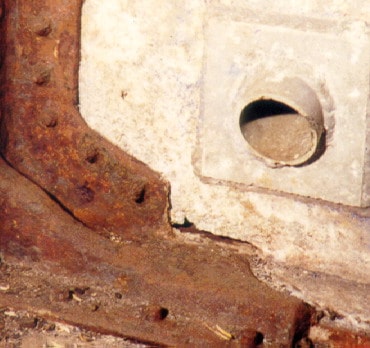
What Is Corrosion?
Each metal has a property known as its ‘standard electric potential’, which describes how likely it is to react with oxygen (or be involved in any other redox reaction). Gold is the classic example of a ‘noble’ (non-reactive) metal, and iron is the obvious example of a reaction-prone one; some other metals like zinc and magnesium are highly active (react very quickly), to the extent that they are used as sacrificial anodes.
Oxidation in Humid Environments
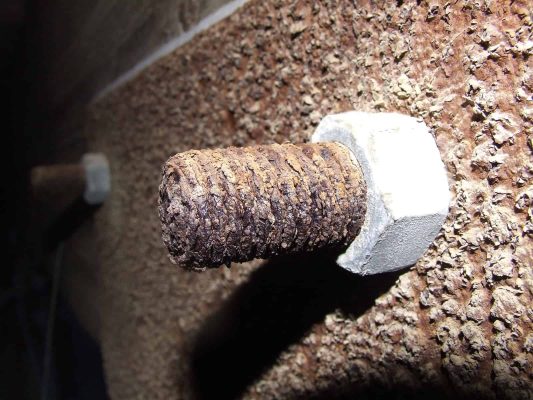
Oxidation (known as rusting when there’s iron involved) is the simplest and most common cause of corrosion, especially on cars. Water gets into contact with some bare metal, so it slowly oxidizes and fails or falls apart entirely.
Everyone knows that each molecule of water is made up of two hydrogen atoms and one oxygen atom. Rain, seawater, and even tap-water aren’t quite pure though; these all contain a few some ‘impurities’ including dissolved gasses (nitrogen, oxygen, and carbon dioxide), as well as some trace minerals, and sodium chloride (salt) in the case of seawater. The oxygen in the water, as well as the dissolved oxygen and carbon dioxide molecules can all provide oxygen atoms to oxidize the metal.
Oxidization happens very slowly in cold and pure water, but salts (or minerals) provide a handy way for electrons to travel, and heat provides the energy for the reaction. Road salt and slush are an unfortunate combination for car and truck bodywork, as the slush sticks to the car providing oxygen atoms, and keeping the conductive brine in contact with the vulnerable sheet metal. Unlike road-going vehicles, boats tend to do better in cold climates than in warm climates. Ocean-going boat hulls and decks are almost constantly damp with brine, so cold weather serves to slow corrosion; boats kept in warmer climates like the Caribbean are subject to much faster metal deterioration.
Metals Dissolving into Solution
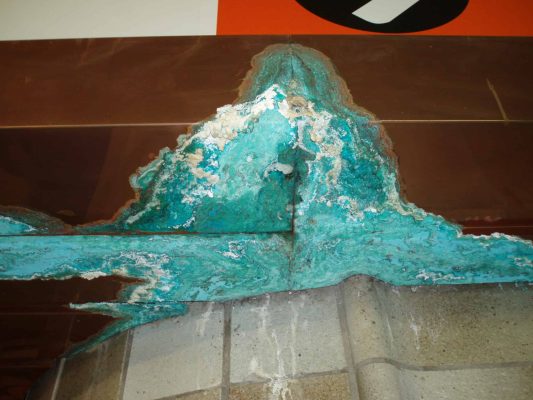
This is an exotic-sounding, but common cause of corrosion. The dissolving metal effect eats away at conductors (especially bare copper) and usually leaves a white or green residue in a round-ish ‘splotch’ on printed circuit boards and electrical panels. Most people don’t recognize this for what it is, though it’s common and you’ve probably seen evidence of it before.
There are many situations where adjacent pieces of metal are at different voltages. If the voltages are different enough and water bridges the gap, the higher-voltage conductor will dissolve into the water. The exact voltage required to produce this effect depends on the standard electric potentials of the metal involved, but the most common voltages found in electrical systems (5V and 12V) are more than enough to dissolve most metals.
This effect happens relatively quickly, even with ‘clean’ water; saltwater and high temperatures each reduce the voltage required for dissolution, but neither is required for this to happen. This type of corrosion is what usually causes battery powered electronics (like cellphones) to fail when they get wet. Metal can also dissolve on terminal bars/strips where some contacts are ‘energized’ and others are grounded (or unpowered), and even in places where exposed conductors or contacts are wet and adjacent to ‘grounded’ vehicular components.
Galvanic Corrosion at Joints
Finally, we have galvanic corrosion, metal’s bogey-man!
This redox reaction occurs wherever two metals with different electric potential are wet and in direct contact, commonly on engine, exhaust, and transmission mounts, as well as electrical connections like terminal strips or grounding points. The most famous example of this reaction was probably the oxidation of the Statue of Liberty’s wrought-iron armature (frame) where it was riveted to her copper skin.
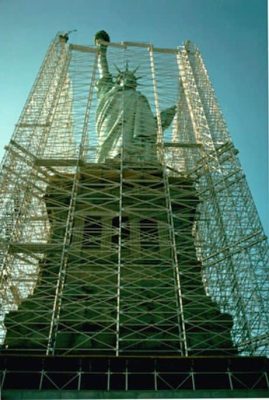
Galvanic corrosion is closely related to the dissolving metal redox reaction; you might even refer to it as the ‘natural version’. In the externally-driven dissolving metal reaction, some outside voltage source provides the energy with causes the metals to oxidize and dissolve. The ‘natural’ redox reaction is driven by the difference in electric potentials of the metals involved.
This process is much slower than the ‘powered’ dissolving metal reaction, because the voltages are miniscule in comparison. Unfortunately, that’s where the good news ends, because galvanic corrosion tends to happen between fasteners and critical components, and there’s usually no sign of a problem until the joint fails catastrophically.
What makes galvanic corrosion especially confusing (to most people) is that it affects ‘corrosion resistant’ materials. Tinned copper, stainless steel, brass, and bronze are all highly dependable corrosion-resistant materials, but they can cause problems when wet and in contact with each other.
Acid Erosion?
Acid erosion is another poorly understood cause of metal deterioration; there are two (very different) kinds of it which are common in vehicles:
- Exhaust gas erosion, very common near automotive and motorcycle tailpipes.
- Wood-acid erosion, most commonly found on boats where metal components such as terminal studs and bus bars are mounted to wood surfaces.
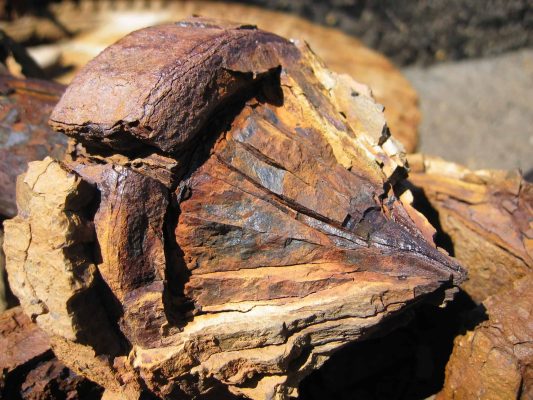
That's All for Now!
- Protecting vulnerable areas, such as connections and splices.
- Drainage, as in preventing electrolytic substances from accumulating.
- Isolation, like keeping different metals separated, so they don’t ‘attack’ each other.
- Sacrificial components and coatings, such as galvanization and sacrificial anodes.
- Electrical techniques, such as grounding or leaving sections of metal floating.